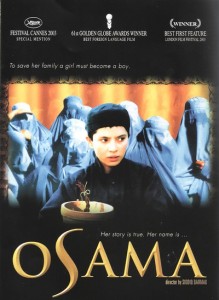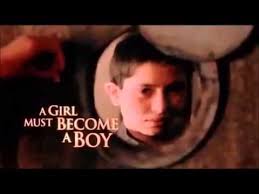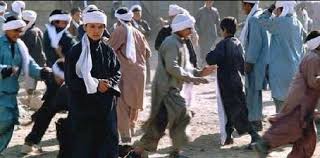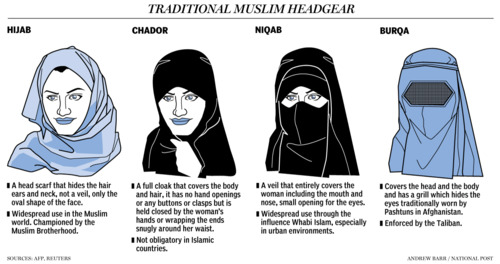Osama, a m oving film directed by Siddiq Barmak, explores the subjugation of Afghan women by the Taliban. Although difficult to watch due to the overwhelming sadness I felt, I was interested to learn that Osama was the first feature length film created in Afghanistan after the fall of the Taliban. This film is moving, melancholic, and eye-opening to the terrors of the Taliban and the oppression and abuse that they exhibited over others, especially Afghan women.
oving film directed by Siddiq Barmak, explores the subjugation of Afghan women by the Taliban. Although difficult to watch due to the overwhelming sadness I felt, I was interested to learn that Osama was the first feature length film created in Afghanistan after the fall of the Taliban. This film is moving, melancholic, and eye-opening to the terrors of the Taliban and the oppression and abuse that they exhibited over others, especially Afghan women.
Osama begins by showing a large group of Afghan women marching and chanting that they want work. The women are are identically dressed in burkas, and many of the women are carrying signs for the protest. Although the women are engaging in a peaceful protest, the Taliban arrive and everything turns violent. They begin shooting at the women, using strong water hoses, and throwing grenades into the crowd. This moment is not even five minutes into the film, and yet it already strongly depicts the Taliban’s cruel treatment of women. In this moment, I felt a pang of sorrow in my heart and in the pit of my stomach–these women are standing up for their rights (which they are clearly not awarded, nor it seems like they have never been) and are being punished for doing so.
It is after this heartbreaking scene that we are introduced to the protagonist, a young girl, and her mother. We quickly learn that they work in a hospital for wages, but the Taliban have raided and taken control of this too. The girl and her mother lose their jobs, leaving them with nothing since all of the men in their life are deceased (this is due to the wars in which they have fought in). And so the young girl and are family are desperate. They are not permitted to work if their household contains no males. Even worse, we learn, is that the women are not allowed to be seen in public unless they are in the presence of a male relative. This is a rule of the terroristic Taliban that is strictly enforced. Thus, a man from the hospital lies and says he is the wife of the young girl’s mother in order to allow them a way home. However, while the young girl and her mother are on the bike ride home with the man, the camera lingers on the young girl’s sandaled foot hanging off the side. The camera lingered there for what seemed like forever; I knew something was going to happen and sure enough it did. At this point, a Taliban approaches the bike and scorns the man and the young girl for having her foot exposed. He yells because her exposed foot could be arousing to men; this is yet another depiction of the horrible rulings of the Taliban. The fact that the young girl’s foot was uncovered could have resulted in serious punishment had she been alone.
Upon returning home, the young girl’s family worries that they will not be able to eat and eventually survive because of the Taliban’s horrible restrictions on women. They cannot leave their house and cannot be seen in public without a man. The young girl’s grandmother (whom I admired from the beginning because she stated that it is her belief that both men and women are equal and equally unfortunate) devises a plan to “change” the young girl into a boy so that she may be able to go out for work in order to help the family survive. The young girl is reluctant and terrified; she fears for the worst–if the Taliban were to find out, she would surely be killed. Again, I felt that pang of despair for the young girl who was forced to be brave in order to help both her family and herself survive.
And so the young girl (who up to this point remained nameless) is given a new identity as a boy named Osama. The remainder of the film follows Osama as she works to earn food for her family, as only men can do, up until the Taliban recruit her for their training, assuming that she is as she appears: a young boy. As Osama is whisked away to “school” under the Taliban’s, we continue to see the ruthlessness and violence of the group. It appeared to me as almost a type of brainwashing of young boys by the Taliban’s, as they yelled at the young boys to dress in the Taliban turban garb, which prompted one young boy to proclaim, “They want to turn us into the Taliban in turbans.” This reminded me of a type of colonization in the way that the Taliban were gathering the young Afghan boys and “schooling” them on their ways, beliefs, and rituals, such as explaining and demonstrating the different ablutions. It reminded me of the colonization occurring in Nervous Conditions, when Nwoye was being educated by the ministries and was being “schooled” to learn the dominant beliefs and culture of the colonizer.
identity as a boy named Osama. The remainder of the film follows Osama as she works to earn food for her family, as only men can do, up until the Taliban recruit her for their training, assuming that she is as she appears: a young boy. As Osama is whisked away to “school” under the Taliban’s, we continue to see the ruthlessness and violence of the group. It appeared to me as almost a type of brainwashing of young boys by the Taliban’s, as they yelled at the young boys to dress in the Taliban turban garb, which prompted one young boy to proclaim, “They want to turn us into the Taliban in turbans.” This reminded me of a type of colonization in the way that the Taliban were gathering the young Afghan boys and “schooling” them on their ways, beliefs, and rituals, such as explaining and demonstrating the different ablutions. It reminded me of the colonization occurring in Nervous Conditions, when Nwoye was being educated by the ministries and was being “schooled” to learn the dominant beliefs and culture of the colonizer. 
As the film continues, Osama remains in “school” training for Bin Laden. There is not a moment that goes by that there is not apparent fear on Osama’s face, in my opinion. She is constantly worried about being caught for passing as a boy, as she knows the ruthless Taliban will kill her since they already subjugate and abuse women that they clearly know are women. As a viewer, I was constantly on edge, hoping with each second that Osama would not be caught, that she could escape this type of imprisonment of the Taliban and return to her family.
Much to my dismay, Osama is eventually found out by the Taliban. How? Her period, of course, a strong indicator of her womanhood. After a cruel punishment of hanging into what appears to be a well, Osama is pulled up, only for the Taliban to discover blood running down her legs.
“Arrest her” is all that can be heard, followed by a mad dash to try to capture a now sprinting and extremely terrified Osama. Eventually she is captured and a burka is immediately thrown onto her as she is whisked away to jail. The worst part? Her punishment, as ruled by the Taliban judge who appears to be no more than a fat slob, is that she is to be married off to a man who appears to be quadruple her age. And so we are back to the extreme limitations on women enforced by the Taliban. Osama, who cannot be older than 13, is to be married off without any bit of say.
Although a mere hour and twenty some minutes long, Osama filled me with a sadness that seems to be sticking with me well beyond the movie. I applaud the director, Siddiq Barmak, for portraying a truth about the Taliban’s cruel mistreatment and subjugation of women. It is a heartbreaking film, but incredibly eye-opening to all, especially those who are oblivious to the hardships and oppression of women all over the world.
This film reminded me of Gayatri Chakravorty Spivak’s essay “Can the Subaltern Speak?” due the depictions of the oppression of women in the film. One way that I looked at the film was that the Taliban was the oppressing/colonizing group in Kabul. I came to this conclusion because of the way in which they took over Afghanistan (both in history and also as depicted in this film–they are all over, monitoring the streets, entering shops, etc.) and forced their radical beliefs onto those in Kabul. For example, we see them “schooling” the young boys in order to form a children’s army for the Taliban. While doing so, the Taliban are forcing their ways onto the young boys in Kabul in a similar manner that a colonizer would to its colonized group of people. When viewing the film this way, it places the people of Kabul as the “colonized.” They seem to be stripped of many freedoms due to the Taliban; even more so, the women are stripped of just about every freedom and they are cruelly oppressed by the Taliban. Thus, the people of Kabul are representative of the colonized subaltern that Spivak discusses, but the subaltern women who are represented in the film, are even further subjugated and given no agency or voice. In her essay, she notes, “If, in the context of colonial production, the subaltern has no history and cannot speak, the subaltern as female is even more deeply in shadow” (Spivak). And so she is, as we can see in Osama. Women in this film are deeply in the shadow of the male-dominated Taliban. They are stripped of any agency, freedom, and individuality through their merciless ruling.
Similarly, I found some connections between Osama and Firdaus, the protagonist of Nawal El Saadwi’s novel Woman at Point Zero. In Woman at Point Zero, Firdaus is oppressed by the men in her society. Because she is a woman, she is subjugated to the abuse of the men surrounding her. Firdaus is forced with a decision: submit to the oppression of the males around her or fight to survive. She chooses the latter, which puts her in a place of resistance against the male dominated society. In this manner, she is similar to Osama, who must make the choice with her family to submit to the oppression of the Taliban and struggle to even live (what with having no means of resources to food as only males can work and leave the house alone) or alter her appearance into a young boy as a means just to survive.
I cannot help but think of Leila Ahmed’s piece “The Discourse of the Veil” when watching Osama. Although I must admit I am not an expert (or nothing even close to that) on customs of Afghan women, I feel as if I have learned enough to not associate the ‘veil’, or in this case, the burqa, with oppression of women. Ahmed warns that there is this monolithic view of Third World Women and the veil as a a means of oppression placed upon women. While I cannot be sure of the true customs of the Afghan women depicted in Osama, I do in some way feel that the burqa was representing oppression, but I cannot be sure and I am even wary of saying that. This is something I went back and forth on, practically driving myself crazy over it, because in one instance the burqa may seem to be a tool of oppression when Osama is found out by the Taliban and they immediately throw the burqa over her, covering her face. Upon another instance, at the court before her ruling, Osama lifts her burqa to see what is going on and a Taliban comes along and throws it down upon her eyes. However, I do not wish to believe that the burqas in this film are representative of oppression. I do not wish to fall into the trap that many have already fell into–that the veil is symbolic of oppression. Ahmed warns us of this, noting that the veil cannot possibly mean one thing across different countries, towns, customs, and religions. Still, having watched and reflected upon the film, I myself cannot define what the burqa is or isn’t symbolic of in Osama. **Upon further research, I have read that the burqa is enforced by the Taliban, which seems to me as if it would be representative of oppression in that it is being enforced. Yet, I am still struggling with this, not wanting to assume that it is signifying something that it may not be. If anyone has some insight or thoughts on this–please share!!**

Reflecting upon this film, I am heartbroken that this even must occur in order for women to survive. I am sickened at the depictions of the oppression of the Afghan women by the Taliban and their ruling that they cannot leave the house without a household male or even work in order to gain food and survive. (Even though I am thankful that Mr. Barmak could bring truth to the world through this film.) It is sickening to think that there are groups that oppress women to the point that they may not be able to survive just one more day. This oppression strips women of their agency, making them reliant on the males in a male-dominated belief system. Osama is heartbreaking, but 100% worth the watch. It has caused me to do even more research into the harsh treatment and oppression of women by the Taliban. I have found a list of bans for women compiled by the Revolutionary Association of the Women of Afghanistan (RAWA) and it is appalling. Check it out here.

Laura,
Stellar piece. I was trying to choose between your piece and a few others to respond to, and your last paragraph hooked me in. I have to admit, that when I read and listened to Leila Ahmed’s ideas on the veil I was not her biggest fan. Although I found much of what she said to be interesting, she seemed to be attempting to speak on the behalf of women who do veil, then backspacing with her words to say that actually, veils can be empowering, then going back to saying that she still finds them oppressing given her upbringing. To find the veil oppressing, given what you saw in “Osama” is, in my opinion, accurate. It all comes down to consent. One of the first questions I got when I started wearing the hijab in college was if I was forced to (which obviously I was not, like what the hell?). If you’re forced to do anything in life, wear the hijab, flee your home, eat grandma’s meatloaf, that is oppression.
LikeLiked by 2 people
Meatloaf. Love it.
I think structural oppression is important in this equation. Are a group of individuals oppressed? Or is a solitary case (meatloaf)?
LikeLiked by 1 person
I think your concern about not speaking about veiling is valid. Keep interrogating yourself. I wasn’t concerned about what you said there. EXCELLENT connections to theory.
LikeLiked by 1 person